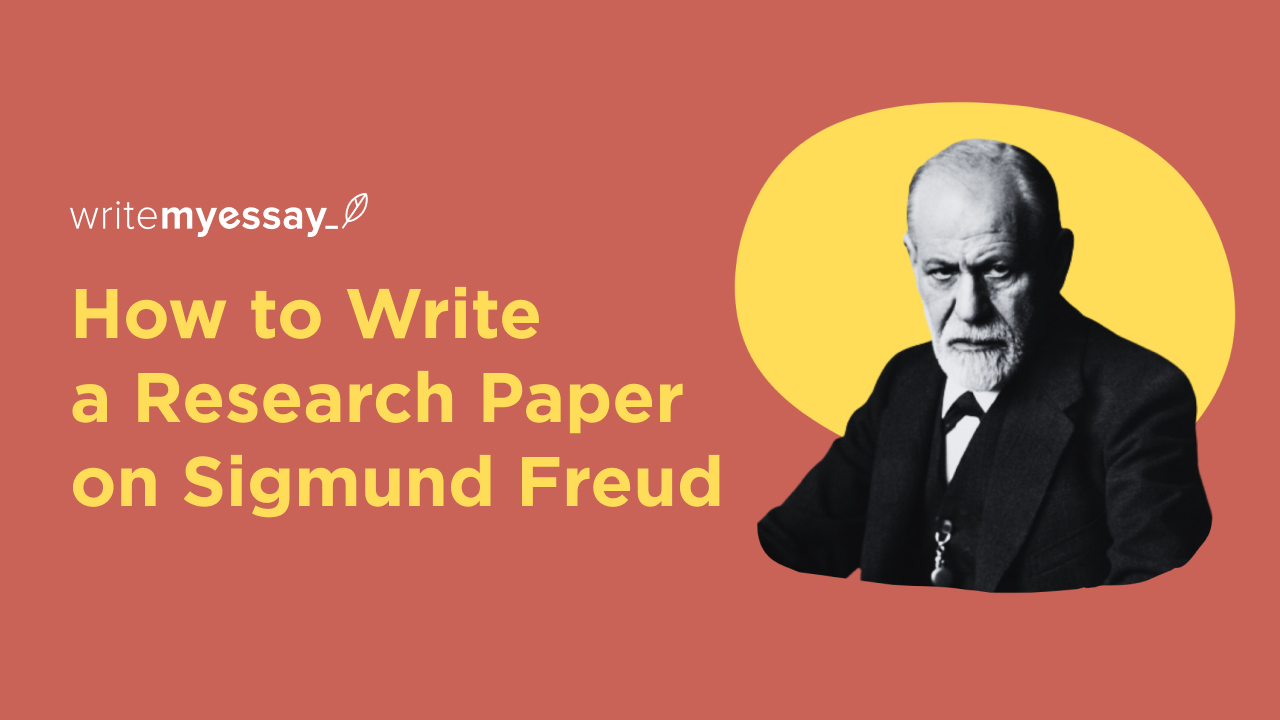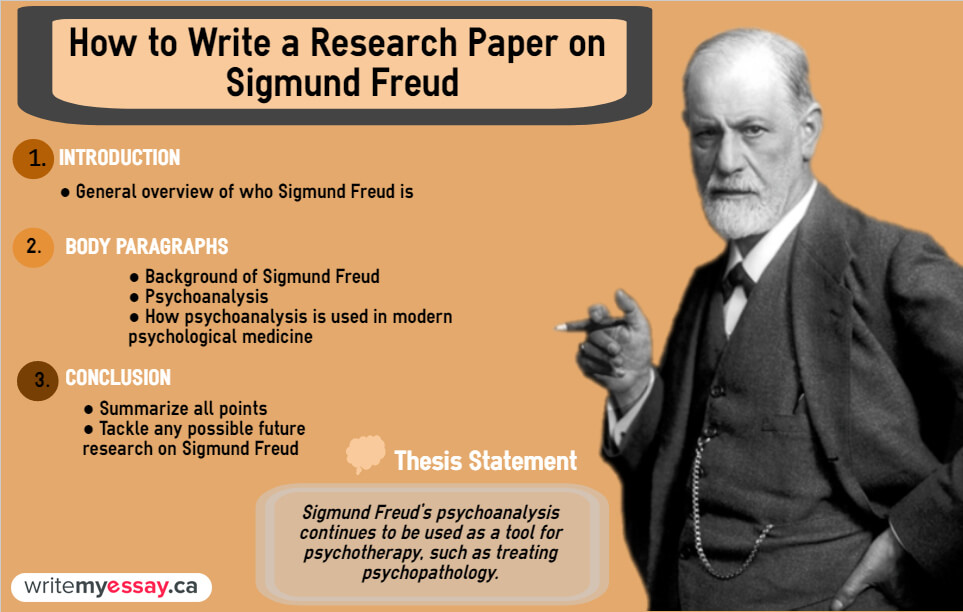
How to Write a Research Paper on Sigmund Freud

Table of Contents
Research Paper on Sigmund Freud
- How to start
- Example of the outline
- How to write the introduction
- How to write the thesis statement
- Example of the thesis statement
- Example of the introduction
- How to write body paragraphs
- Example of the 1st body paragraph
- Example of the 2nd body paragraph
- Example of the 3rd body paragraph
- How to finish your research paper
- Example of the conclusion
- Research paper revision

Research papers continue to play a vital role in a student’s academic life, be it in primary, secondary, tertiary or even graduate school. Such papers will also continue to thrive no matter what subject(s) or course(s) calls for them and as an undergraduate student, you can be tasked to write a paper about Sigmund Freud. Though there have been many essays written about Sigmund Freud, the student cannot help but wonder what to write about him and as such can be stuck. To go on about writing a paper about the great psychologist himself, the student needs to decide to take the simple step by step procedure on how to write a Sigmund Freud paper.
How to start
Before writing down all the theories, analysis, definition, etc. about Sigmund Freud, the author must first consider doing preliminary research. As a psychology undergraduate, a priority to find out who is Sigmund Freud should be done initially and then find out more about what he has done or his background through extensive research and by checking other’s papers since they may act as a guide for the student as well as give them the ideas they need to fulfill their academic requirements.
After examining peer papers, the author must then list down all three subtopics they wish to talk about their work. When they are done, they must now conduct extensive research and see if there are papers written about them so they can be deemed feasible. Since the topic is about Sigmund Freud, some contents that the undergraduate can write about is who Sigmund Freud is, what is his contributions and how his psychoanalytic theory continues to be used today. Simply, the undergraduate must take into account the topics they wish to discuss since the paper has to be factual in all aspects and must not contain opinions which cannot be backed up by illegitimate sources.
Example of the outline
In writing the outline, it should contain only short and concise information about Sigmund Freud and that it is written in an organized manner. The outline should also be divided based on the introduction, body and conclusion portion of the paper.
I. INTRODUCTION
- General overview of who Sigmund Freud is
II. BODY PARAGRAPHS
- Background of Sigmund Freud
- Psychoanalysis
- How psychoanalysis is used in modern psychological medicine
III. CONCLUSION
IV. References
The outline plays a vital role as a guide to make sure that the student was able to write in a neatly organized and time-saving manner. The outline also plays as a correction for sub-topics talked about should necessary changes be made to the overall content of the student’s work.
How to write the introduction
An introduction can be written in an array of ways but the totality of the content of the introduction must retain one principle and that is to make sure that the undergraduate’s audience read the paper from head-to-toe (introduction to the conclusion). Now the question is, how does one go about this?
1. Start with a hook
A hook sentence is a type of sentence that immediately grabs the attention of the readers. The hook sentence can range from startling information – a piece of information that may or may not be known to many such statistics of how many patients were exposed to psychoanalysis as of the year 2017, a dialogue between two speakers, an illustration or an anecdote so that the author may get his or her point across and summary of information to give a brief overview of the main idea of the paper. The student must take into mind that not all audience are psychologists or are knowledgeable about the field so starting from this hook sentence until the end of the essay, the author must be wary to use terms which can be understood by all unless instructed to be specific about keywords used.
2. Search for relevant information
Information used for the research must be relevant in all aspects and must avoid information that can make the author wander off from the original point they were trying to make.
3. Avoid clichés statements
In this aspect, the writer must make an effort to avoid sentences, phrases or other data which are known to many, if not all.
4. State the worth of the work
This is the most important part of the introduction because as an author, the student must do everything in their power to make sure that they state the value of their work. They must be able to state what the audiences would be missing should they miss out on reading their paper and this can be taken from the hook sentence(s) made.
5. The introduction can come after the body paragraphs
There is no need to be pressured to write the introduction immediately since this can come after writing the body paragraphs.
How to write the thesis statement
A thesis statement serves as the core of any essay so it should have the element to be a strong main idea. The thesis statement should be written in a clear and concise manner so the author must avoid the use of vague words. The thesis statement should also be written shortly since outstretching this portion of the paper will lead to confusion and conflict among the readers and the content of the paper itself.
Example of the thesis statement
Sigmund Freud’s psychoanalysis continues to be used by neurologists as tools for psychotherapy such as treating psychopathology and to better understand this an in-depth discussion of what psychoanalysis and how they are used in the medical world will be discussed.
Example of the introduction
Sigmund Freud was a neurologist and the father of psychoanalysis. Freud was able to revolutionize treatment and the understanding of mental or psychological disorders, thus leading to the creation of the psychoanalytic theory of personality. (Insert thesis statement here) – “Sigmund Freud’s psychoanalysis continues to be used by neurologists as a tool for psychotherapy such as treating psychopathology and to better understand this an in-depth discussion of what psychoanalysis and how they are used in the medical world will be discussed.”
How to write body paragraphs
Writing the body paragraphs also follow a step-by-step procedure by following the same principles on how to write the introduction and the conclusion.
- Make sure to write down ideas which rotate around the thesis statement.
- Write down all supporting points for the sub-topics.
- Elaborate the supporting points by providing facts. To elaborate the supporting points, the student has to go over all the information they had accumulated regarding their paper. Since the topic is about Sigmund Freud, it is important to gather data from legitimate sources such as peer-reviewed journals and medical books on psychoanalysis.
- The student may include a summary of each body paragraph.
- Review the body paragraph for proper citation.
Example of the 1st body paragraph
Sigmund Freud was born to Jewish (Galician) parents in Moravian, Austria. He studied medicine at the University of Vienna. Once he was complete with his habilitation, he assigned to be a neuropathologist and later on became a professor back in 1902 [1]. When Freud was creating his psychoanalysis theory of personality, he was able to discover numerous therapeutic techniques and was able to redefine sexuality such as the formation of the Oedipus complex which served as the central idea of the psychoanalytical theory.
Example of the 2nd body paragraph
Psychoanalysis is a type of psychopathologic treatment created by Sigmund Freud and is continued to be used today. Psychoanalysis essentially treats mental disorders through the investigation of the individual’s interaction of conscious and unconscious parameters in the mind. These conscious and unconscious parameters known as the ego, id, and superego can bring about repressed emotions such as fears and conflicts and can be used as an interpretation of dreams and their association.
Example of the 3rd body paragraph
Through the use of psychoanalysis, neurologists are able to relieve people of their constraint to express their emotions and experiences by making these “unconscious” emotions “conscious”. Psychoanalysis also continues to be used as the treatment for mental disorders through this method of awakening. Psychoanalysis also helps the patient to develop awareness of their “unconscious” or repressed processes.
How to finish the research paper
To end the paper, the author must be able to include these elements into the conclusion:
- Reaffirm the thesis statement
- Summarize all points made
- Tackle any possible future research on the topic
- Acknowledge the paper’s limitations
- Give their last impression of the topic and the paper
The conclusion also has three to four sentences to finish the paper.
Example of the conclusion
Though psychoanalysis was created back in the 19th century, it continues to play a vital role in the treatment of mental disorders. In essence, though it has its own limitations, Freud’s theory on psychoanalysis continues to fill the void and complete the dialogue between members of the general public which has concerns on mental health, culture and even politics. In essence, the psychoanalysis theory of personality continues and will continue to further aid the revolutionizing and understanding of the human personality.
Research paper revision
Since this type of paper is fact-specific wherein valid points should only be made, it is necessary that the author must consult with his or her peers or someone extensively knowledgeable about this topic. Afterward, proper editing and revision should be done before submitting the work.
- [1] Kandel, E.R. (2012). The Age of Insight: The Quest to Understand the Unconscious in Art, Mind and Brain, from Vienna 1900 to the Present. New York: Random House, pp. 45–46.


